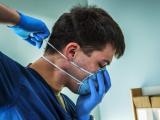Apr 20, 2004 (CIDRAP News) – Federal government researchers have reported promising results in animal testing of a candidate SARS (severe acute respiratory syndrome) vaccine that combines a weakened form of vaccinia virus with a gene from the SARS coronavirus.
The report from the National Institute of Allergy and Infectious Diseases (NIAID) comes just 3 weeks after the agency reported favorable results in animal experiments with another candidate SARS vaccine. Both vaccines were tested in mice, which can be infected with the SARS virus but do not become visibly sick. The new report was published online by the Proceedings of the National Academy of Sciences (PNAS).
"We now have two candidate vaccines, based on two distinct technologies, shown to be effective against SARS infection in mice," said NIAID Director Anthony S. Fauci, MD, in a news release.
The latest vaccine candidate was developed by a team led by senior author Bernard Moss, MD, PhD. The team used modified vaccinia Ankara (MVA), a weakened form of the smallpox vaccine, as a vehicle to move a SARS virus protein into cells. Other NIAID researchers are currently testing MVA, which was developed in Germany in the 1960s, as a potentially safer substitute for the conventional smallpox vaccine.
The SARS virus and other coronaviruses have spiky proteins protruding from their surface, giving them a crown-like appearance, the NIAID noted. Because the spike (S) protein enables the virus to attach to and enter cells, a vaccine based on the S protein should closely imitate natural SARS infection, Moss said in the NIAID news release. Moss's team created the vaccine by inserting the gene encoding the S protein into MVA.
In the experiment, two groups of eight mice received two doses of the MVA/S vaccine, delivered either intranasally or intramuscularly, 4 weeks apart. Other groups of mice received either a mock vaccine or the MVA vaccine without the S protein gene, according to the PNAS report. A month after the second dose, the mice were exposed intranasally to the SARS coronavirus.
When the MVA/S-immunized mice were examined 2 days after this exposure, the researchers found little or no viral replication in the lungs and nasal passages, according to the report. The findings were the same for both vaccination methods. Significantly higher levels of virus were seen in the control mice.
The researchers also tested the blood of immunized mice to measure the level of antibodies to the virus, the NIAID reported. "Mice immunized with the MVA/S vaccine developed S-specific neutralizing antibodies. Control mice immunized with MVA alone did not develop antibodies and were not protected from SARS infection."
The study also showed that immunity to SARS can be acquired passively, the NIAID said. After serum from MVA/S-immunized mice was injected into nonimmunized mice, the latter fended off the SARS virus almost as well as vaccinated mice did.
Bisht H, Roberts A, Vogel A, et al. Severe acute respiratory syndrome coronavirus spike protein expressed by attenuated vaccinia virus protectively immunizes mice. Proc Natl Acad Sci 2004;101(17):6641-6 [Abstract]
See also:
Mar 31 CIDRAP News story, "SARS vaccine works well in mice, NIAID says"




















